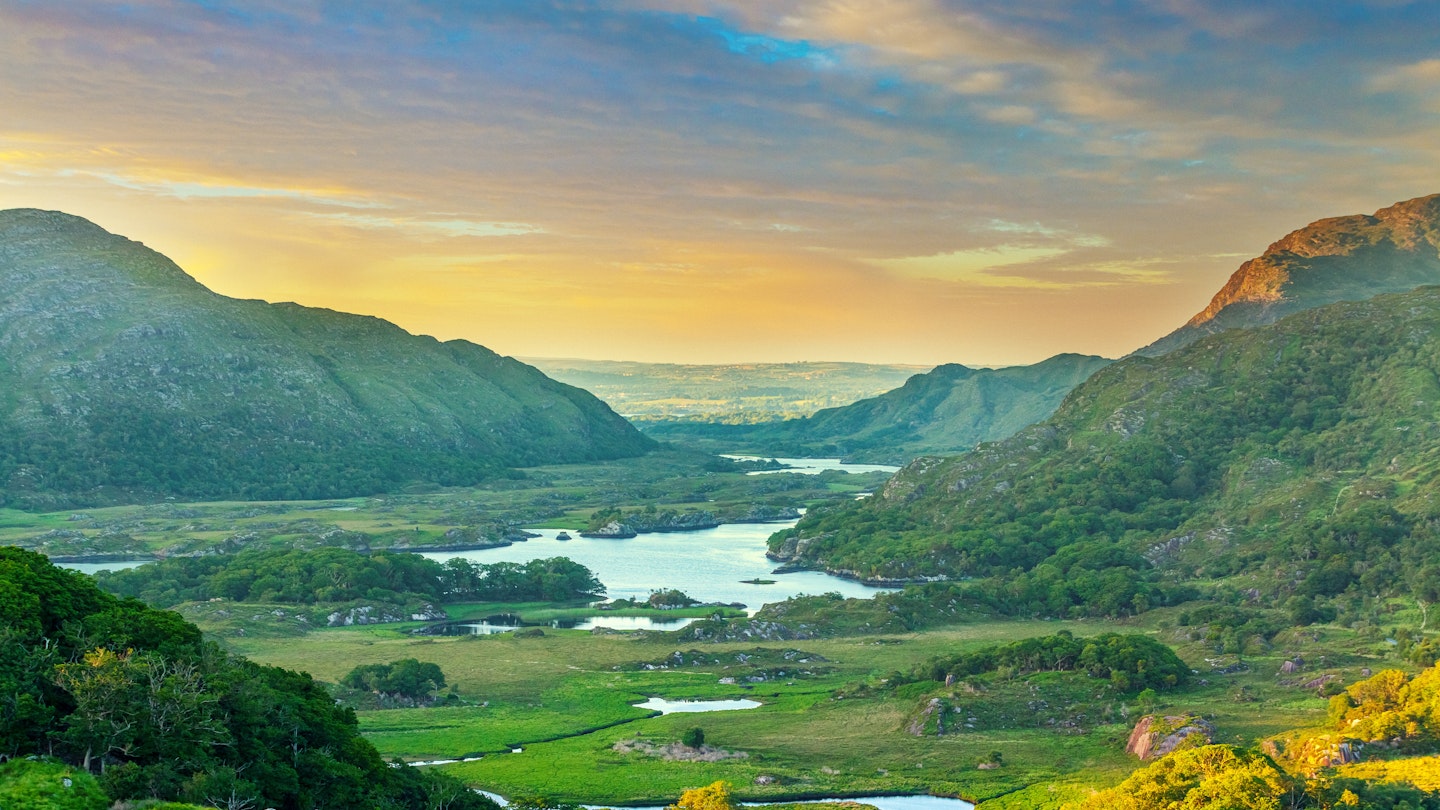Exploring Ireland’s National Parks
Exploring the cinematic canvas of Ireland’s national parks is a journey through ancient oak woodlands, swaths of blanket bog shaped like lunar outposts, glassy lakes, and dramatic green mountains shrouded in mist.
Ireland has six national parks; five are located on the west coast, and one can be found on the east, just an hour from Dublin. Most can be explored in less than a day and are generally suited to all ages and levels of fitness. However, you can find some challenging trails if you’re up for a test of endurance. Although great weather may not be guaranteed when visiting Ireland’s national parks, one thing you can be sure of is the otherworldly vistas, regardless of the sun’s presence.
Killarney National Park
Best for lakes
Sprawling over 10,236 hectares, the sublime Killarney National Park is an idyllic destination to explore. Notable attractions like Ross Castle and Muckross House draw many visitors. Nonetheless, it’s easy to escape to Ireland’s largest area of ancient oak woods, which offers panoramic views of its highest mountains and the country’s only wild herd of native red deer.
The heart of the national park is the Muckross Estate, donated to the state by Arthur Bourn Vincent in 1932; the park was designated a UNESCO Biosphere Reserve in 1982. The Killarney Lakes, namely Lough Leane, Muckross Lake, and the Upper Lake, comprise about a quarter of the park and are surrounded by natural oak and yew woodland, overlooked by the high crags and moors of Purple Mountain (832m) to the west and Knockrower (552m) to the south.
The Burren National Park
Best for flora
Visiting the Burren National Park feels like stepping onto another planet. Located on the south-eastern tip of the Burren in Co Clare, this national park is Ireland’s smallest at just 15 sq km. Its lunar landscape is marked by limestone grasslands and pavements, interspersed with grasslands and hazel and ash woodlands. What sets the Burren apart is its extraordinary flora, showcasing a unique combination of Arctic-Alpine plants growing alongside Mediterranean plants in the same habitat.
Moreover, the Poulnabrone Dolmen stands as a remarkable megalithic tomb, known as Ireland’s most photographed ancient monument, dating back to the Neolithic period. Burren National Park also features Dromore Wood, where you’ll find the 17th-century O’Brien castle and other historical landmarks. The park has seven way-marked walking trails, and its proximity to the famous Cliffs of Moher makes it an appealing destination.
Glenveagh National Park
Best for wildlife
As Ireland’s second-largest national park, Glenveagh is a tapestry of lakes overlooked by majestic mountains, with valleys shaped by time and dotted with forest and swathes of bog, offering an unspoiled landscape coupled with excellent hiking options for all fitness levels. Its wealth of wildlife includes the golden eagle, once hunted to extinction here in the 19th century but reintroduced in 2000, alongside the country’s largest herd of red deer.
Such tranquility came at a heavy cost. The land was previously farmed by 244 tenants, who were forcibly evicted by landowner John George Adair in the winter of 1861. Adair later constructed the stunning lakeside Glenveagh Castle (1870–73), while his wife introduced the park’s definitive red deer and rhododendrons.
Wicklow Mountains National Park
Best for wild camping
Wicklow Mountains National Park spans just over 200 sq km of mountains, blanket bog, and woodland. Within its borders are two nature reserves, protected by the Wildlife Act 1976. The larger reserve, west of the Glendalough Visitor Centre, conserves the extensive heath and bog of the Glendalough Valley, including the Upper Lake and valley slopes. The second, Glendalough Wood Nature Reserve, protects the oak woods stretching from the Upper Lake toward Rathdrum.
It takes approximately an hour by car to reach Wicklow Mountains National Park from Dublin. This park is the most visited in Ireland, attracting over one million visits per year due to its proximity to Dublin. While the bulk of visitors congregates in Glendalough, it is possible to find solitude in the less-trodden uplands. The park offers nine way-marked walking trails that vary from a child-friendly half-hour trek to a more invigorating four-hour hike. Thus, it’s a favored location for wild camping.
Connemara National Park
Best for bird-watching
Located immediately southeast of Letterfrack, Connemara National Park encloses dramatic hectares of bog, mountains, heath, and woodlands. The park includes several of the Twelve Bens, such as Bencullagh, Benbrack, and Benbaun. Nature enthusiasts will relish the fine walking paths along the glen and surrounding mountains, as well as short self-guided trails. Guided nature walks led by park rangers also offer enriching experiences.
The park is known for its diverse birdlife; above, you can spot songbirds such as skylarks and robins, along with birds of prey like the kestrel and peregrine falcon. Moreover, winter is an excellent time to witness native birds like woodcock and song thrush, alongside migratory species from northeastern Europe.
Ballycroy National Park
Best for stargazing
This expansive park, home to some of Europe’s greatest areas of blanket bog, boasts magnificent natural diversity, featuring peregrine falcons and whooper swans. Ballycroy was designated a Gold-Tier International Dark Sky Park in 2016, making it an ideal spot for stargazing. According to Mayo Dark Sky Park, on a clear night, visitors can see over 4,500 twinkling stars, alongside other planets in our solar system, The Milky Way, and even meteor showers with the naked eye.
Though there are no serviced campsites in the park, wild camping is permitted for those wishing to spend a night beneath the stars. A short nature trail leads from the visitor center in Ballycroy across the bog, revealing spectacular views of the surrounding mountains, while staff can recommend more ambitious hikes and provide information on local natural history.





